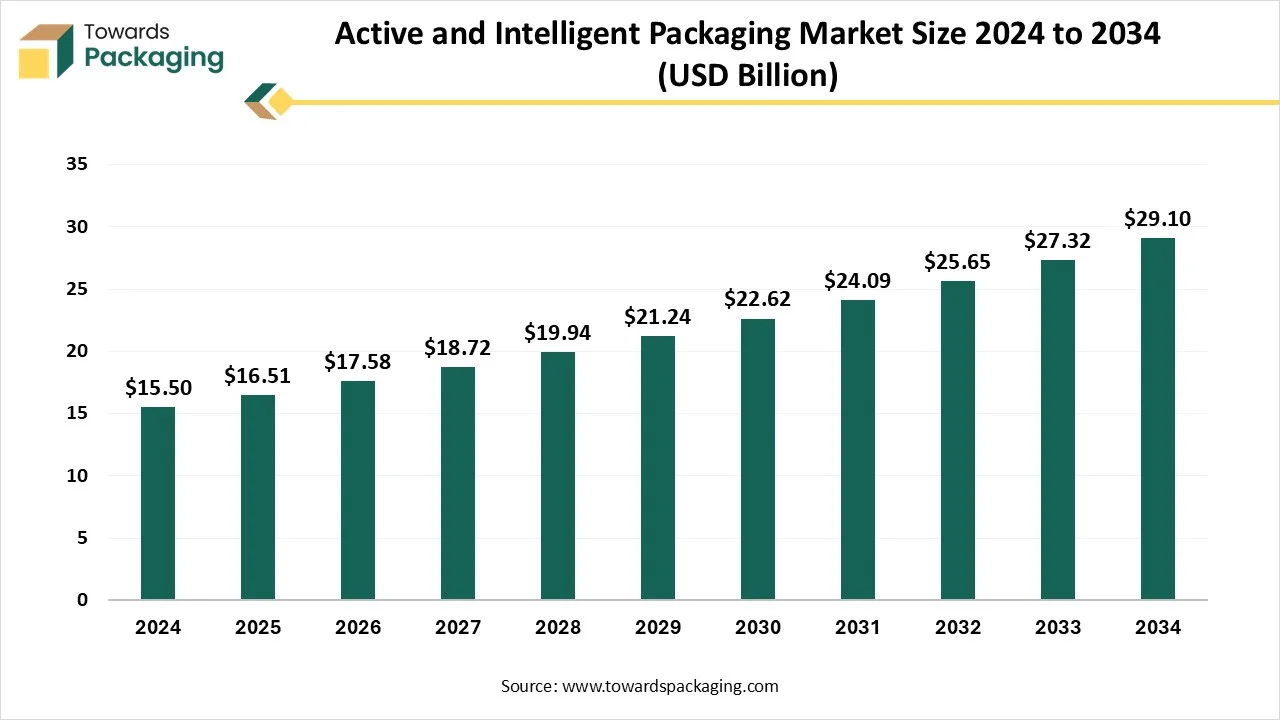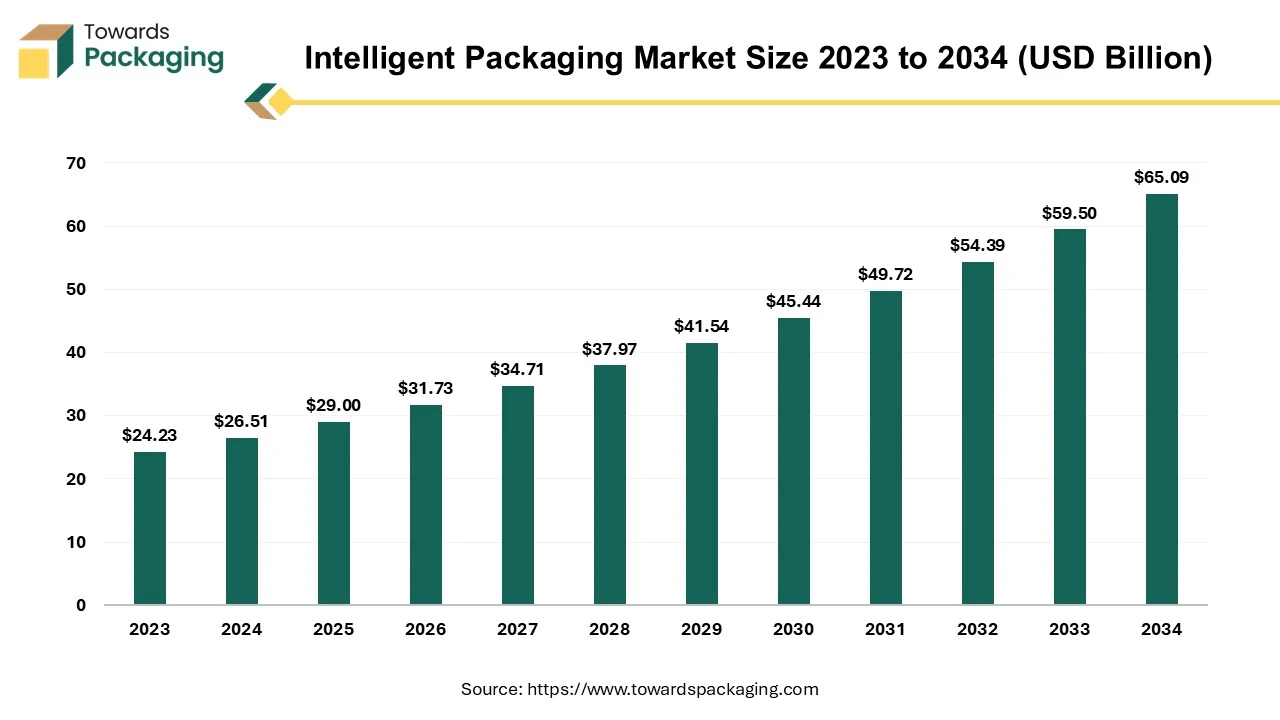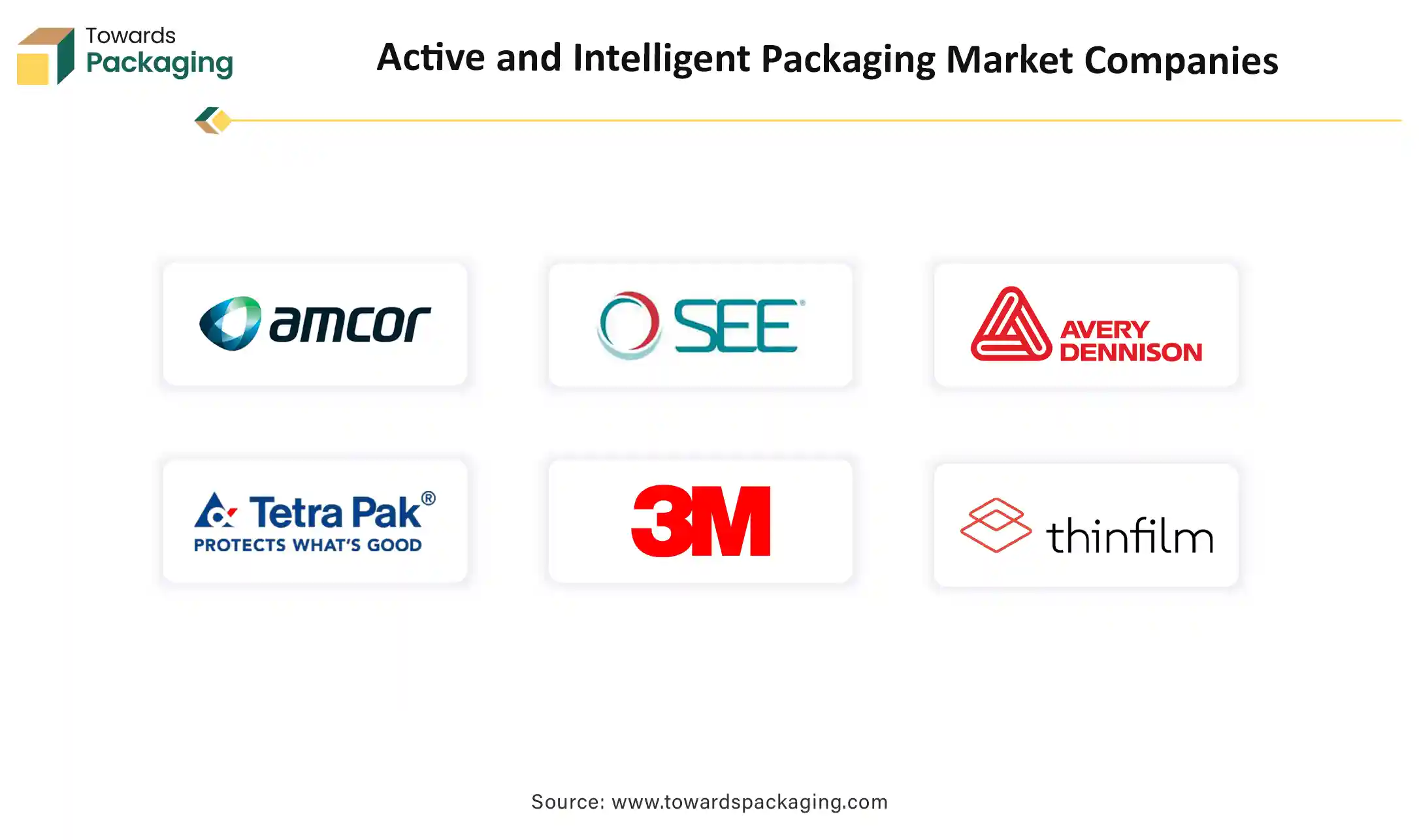December 2025
The active and intelligent packaging market is analyzed in detail from USD 16.51 billion in 2025 to USD 29.1 billion by 2034, growing at a CAGR of 6.5%, with full statistical coverage of year-wise market size, regional shares (North America 34%, Europe 25%, Asia Pacific 20%, Latin America 12%, Middle East & Africa 9% in 2024), and technology splits (active packaging 60%, intelligent packaging 40%). The report covers trends such as RFID, TTIs, smart labels, QR/NFC, AI integration, and provides quantified data by function (shelf-life extension 50%, product integrity monitoring 20%, etc.), material (plastics 55%, biopolymers 7%, and others), and end-use industries (food & beverage 48%, healthcare & pharmaceuticals 20%, etc.), along with trade data, value chain analysis, and detailed manufacturer & supplier information.

The global active & intelligent packaging market involves advanced packaging systems that go beyond traditional containment and protection by enhancing shelf life, monitoring product conditions, and improving consumer interaction. These solutions are widely applied across industries like food & beverage, healthcare, pharmaceuticals, logistics, cosmetics, and electronics. Smart packaging pertains to packaging that utilises technology to develop the user experience. It consists of the main elements: active packaging and intelligent packaging. Active packaging communicates with the product. It can incorporate oxygen or release preservatives. This assists in expanding shelf life and tracking quality. Intelligent packaging serves to convey information about the product's condition. It may contain sensors that examine freshness or temperature.
Artificial Intelligence (AI) is fastly changing sectors across the globe, and the packaging industry is no exception. From production and design to quality control and logistics, AI-powered software is making sure the latest era of sustainability, efficiency, and invention. AI is changing the way packaging is crafted. Generative design algorithms can quickly make hundreds of capable packaging designs depending on particular elements like material constraints, product information, and even aesthetic choices. This ultimately develops the design procedure that allows companies to discover a wider range than would be possible with regular procedures.
Algorithms can examine historical sales data, market trends, and other factors to predict upcoming demand for packaging materials. This assists companies in reducing waste, inventory levels, and avoiding stockouts. AI-powered systems can update warehouse layouts and inventory management, develop efficiency, and lower storage costs.
The global active and intelligent packaging technologies can significantly expand the shelf life of vegetables and fruits. BY constantly tracking internal conditions, these systems can track temperature and humidity fluctuations, preventing contamination and spoilage. A main takeaway is that the dual role of smart packaging is food security. Primarily, it makes sure that optimal storage conditions are met, lowering risks linked with decomposition and microbial growth. Secondarily, its tracking characteristics serve users with real-time insights into food quality, allowing more informed purchasing decisions.
The incorporation of high-level technologies like trackers and sensors can increase the cost of packaging. Medium-scale and small businesses may find it challenging to use them. Executing active and intelligent packaging needs to meet current systems, such as supply chain management software. This can be time-consuming and resource-intensive, too. Collecting and keeping consumer data creates privacy problems that need to be solved through robust data security measures and compliance with regulations. The cost of incorporating high-level technologies can be high, and there may be issues about data security and privacy, specifically with IoT-enabled packaging. Furthermore, a huge spread of acceptance needs partnerships between producers, retailers, and users to ensure compatibility and effectiveness.
Like regular packaging procedures, active and intelligent packaging can capture and share valuable information automatically, lowering manual tasks and the risk of human error. The urge for faster, more accurate deliveries is greater than ever, and sectors are under pressure to ensure smooth operation and customer satisfaction. Smart packaging aligns with these demands by serving precise, up-to-the-date data on products as they shift through every stage of delivery and production. Furthermore, smart packaging serves important environmental advantages. By vanishing errors and developing effectiveness, it cuts down on wasted materials and unwanted shipments, resulting in a smaller carbon footprint. This is heavily important as consumers and businesses alike prioritize sustainability.
Active packaging brings a step forward by communicating with the product or its surroundings to maintain quality. For example, oxygen absorbers in food packaging prevent wastage, while moisture absorbers control moisture levels. Some pharmaceutical organizations use temperature-regulating material to make sure that medicines stay stable during transit. This kind of packaging is especially expensive for sensitive goods and products. In sectors like pharmaceuticals, food, and electronics, tracking and controlling product integrity is important.
Active packaging expands its shelf life and lowers waste by diminishing damage or spoilage during transportation. Active packaging plays a crucial role in expanding the shelf life of products. It communicates with the product or the surroundings to track freshness and quality. Oxygen scavenger elements in packaging incorporate oxygen, which can cause food spoilage. By removing oxygen, the packaging maintains the product fresh longer.
Intelligent packaging includes technologies like RFID (Radio Frequency Identification ), NFC ( Near Field Communication), sensors, and QR Codes. This packaging includes packaging with a bustle, changing it into a dynamic area of invention and information. An important element of intelligent packaging is its potential to serve real-time data analytics. Intelligent packaging has adopted augmented reality to create captivating brand experiences. Users can scan packaging with their smartphones to unlock communicative materials, developing engagement and viral product trials, and leaving a lasting impression.
Plastic is prevalently utilised in different industries because of its low cost, long durability, and long performance too. It is specifically well-suited for packaging, as many forms of plastic are allowed to withstand heavy environmental conditions. Hence, it is accurately using elements that also make it non-biodegradable and toxic to the environment. Governments and international organisations can impose regulations that solve the main exporters and polluters, while also fostering worldwide co-operation.
Biopolymers are gaining attention as an environmentally friendly alternative to regular petroleum-based plastics, especially in the packaging sector. PLA and starch-based plastics stand out, for example, celebrated for their biodegradability and compostability. These materials are derived from renewable resources such as sugarcane or corn-starch procedure, which only contributes to lowering carbon emissions but also assists in decreasing the accumulation of waste in landfills.
The acceptance of PLA and biopolymer in different packaging uses -from disposable cutlery to agricultural films and food packaging-shows their practical utility and rising adoption in industries such as actively finding sustainable alternatives. Further expanding their capability beyond packaging, research is diligently discovering the potential of biopolymers in high-value uses that were regularly dominated by conventional plastics and metal.
The importance of shelf life extension is complicated. For users, it transforms food waste at home and provides access to products that remain fresh for a longer time. For businesses, it means to stretch market reach, decrease spoilage loss, and develop possibilities. From a huge societal point of view, effective shelf life extension invests in huge food security, resource conservation, and environmental sustainability by lowering waste and improving resource utilization. Going beyond passive updation, active packaging includes elements that release or absorb substances into or from packaged food or the headspace.
Global active and intelligent packaging ensures product safety by making sure and by tracking quality in real-time and examining issues like spoilage, contamination, or temperature fluctuations. For instance, in the food industry, active packaging can identify unsafe conditions during production and transportation, and lower waste through proactive alerts. This potential makes sure products remain safe while lowering losses. By using active and intelligent packaging technologies like moisture regulators and oxygen absorbers, smart packaging creates perfect surroundings inside the package, which prevents spoilage and extends freshness. These solutions are specifically valuable for sensitive products, mainly reducing product adaptability by preserving quality for longer periods.
Active and Intelligent packaging is widely utilized in the food and beverage industry. In the food sector, it assists in reducing waste and improving safety by utilizing sensors that manage temperature exposure and freshness indicators that display if a product is still safe to consume. Smart labels also serve expiry dates and storage details, which make sure consumers have precise product information. For example, oxygen scavengers, which are specifically composed of iron-based compounds, are widely used in food packaging to lower oxygen levels inside a sealed package. This slows down oxidation, an initial cause of food deterioration. Meat and dairy products, which are highly vulnerable to spoilage because of oxygen exposure, benefit mainly from these solutions.
In pharmaceuticals and healthcare solutions, active and intelligent packaging solutions can protect against drug degradation by tracking environmental conditions. For instance, temperature-sensitive packaging can track drug viability, with reports showcasing effectiveness levels remaining about 90% throughout shipping. This growth in smart packaging, subject to nanotechnology, is changing how sectors monitor and maintain track integrity, which leads to enhanced safety and quality assurance for users.
North America has a strong concentration on invention and technology. Several companies are investing in active and intelligent packaging to improve product safety and freshness. Users are also very aware of safety and food quality, which drives the demand for packaging that serves more information and protection, too. Additionally, the trend towards sustainability has encouraged organizations to accept eco-friendly packaging solutions. Consumer choices, strict regulatory standards, and major investments in technological growth are further fueling the region's industry expansion.
The urge for active and intelligent packaging is rising quickly in Asian Countries due to growing food security, urbanization, and a stretched middle class. Countries like China, India, and Japan are experiencing increased use of packaged food, pharmaceuticals, and electronics, too, driving the demand for packaging that expands the product shelf life, tracks product quality and ensures safety. Active packaging solutions such as oxygen scavengers, moisture absorbers and antimicrobial growth are gaining attention across pharma, food and FMCG sectors. Furthermore, rigid regulations and growing exports are pushing producers to accept smart and functional packaging technologies.
The active packaging market is projected to reach USD 45.69 billion by 2034 growing from USD 22.17 billion in 2024, expanding at a rapid CAGR of 7.5% between 2025 and 2034. The rising consumer demand for fresh and minimally processed products drives the need for packaging that preserves quality and extends shelf life. The expansion of online food and pharmaceutical sales increases the requirement for packaging that ensures product safety and freshness during transportation.

The key players operating in the market are focused on adopting inorganic growth strategies like acquisition and merger to develop advance technology for manufacturing active packaging which is estimated to drive the global active packaging market over the forecast period.
The advanced type of packaging engineered to interact with the product which contains to extend shelf-life, maintain quality, and enhance safety is known as active packaging. The active packaging only serves as a passive barrier, active packaging actively responds to environmental changes and improves the condition of the packaged product. The key functions of active packaging are extending shelf life, maintaining freshness, enhancing safety, and improves product quality.
The global intelligent packaging market is set to grow from USD 29 billion in 2025 to USD 65.09 billion by 2034, with an expected CAGR of 9.4% over the forecast period from 2025 to 2034. The rise in demand for safer, traceable, and tamper-proof products across sectors like food, pharma, and e-commerce is driving the shift toward advanced solutions. The growing consumer need for transparency, combined with regulatory pressure to ensure product integrity, is accelerating market expansion.

Intelligent packaging creates interactive and useful packaging solutions by fusing cutting-edge technologies with conventional packaging. It is made to satisfy consumer demands for longer shelf lives, safer food products, and better customer service. The packaging interacts with the environment and provides clients with extra benefits by utilizing cutting-edge technology like sensors, RFID tags, and QR codes. It can trace the goods along the supply chain, keep an eye on its condition, and give customers pertinent information. Furthermore, cutting-edge elements like augmented reality (AR) experiences are frequently used in smart packaging to improve the overall customer experience.

By Technology Type
By Material
By Function
By End-Use Industry
By Region
December 2025
December 2025
December 2025
December 2025